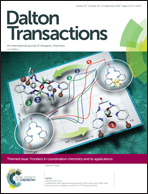Syntheses, structures, and magnetic properties of three new MnII–[MoIII(CN)7]4− molecular magnets†
Abstract
By reaction of K4[MoIII(CN)7]·2H2O, Mn(ClO4)2·6H2O and bidentate chelating ligands, three new cyano-bridged compounds, namely Mn2(3-pypz)(H2O)(CH3CN)[Mo(CN)7] (1), Mn2(1-pypz)(H2O)(CH3CN)[Mo(CN)7] (2) and Mn2(pyim)(H2O)(CH3CN)[Mo(CN)7] (3) (3-pypz = 2-(1H-pyrazol-3-yl)pyridine, 1-pypz = 2-(1H-pyrazol-1-yl)pyridine, pyim = 2-(1H-imidazol-2-yl)pyridine), have been synthesized and characterized structurally and magnetically. Single crystal X-ray analyses revealed that although the chelating ligands are different, compounds 1 to 3 are isomorphous and crystallize in the same monoclinic space group C2/m. Connected by the bridging cyano groups, one crystallographically unique [Mo(CN)7]4− unit and three crystallographically unique MnII ions of different coordination environments form similar three-dimensional frameworks, which have a four-nodal 3,4,4,7-connecting topological net with a vertex symbol of {43}{44·62}2{410·611}. Magnetic measurements revealed that compounds 1–3 display long-range magnetic ordering with critical temperatures of 64, 66 and 62 K, respectively. These compounds are rare examples of a small number of chelating co-ligand coordinated [Mo(CN)7]4−-based magnetic materials. Specifically, the bidentate chelating ligands were successfully introduced into the heptacyanomolybdate system for the first time.
![Graphical abstract: Syntheses, structures, and magnetic properties of three new MnII–[MoIII(CN)7]4− molecular magnets](/en/Image/Get?imageInfo.ImageType=GA&imageInfo.ImageIdentifier.ManuscriptID=C8DT01433G&imageInfo.ImageIdentifier.Year=2018)
- This article is part of the themed collection: Frontiers in coordination chemistry and its applications


 Please wait while we load your content...
Please wait while we load your content...